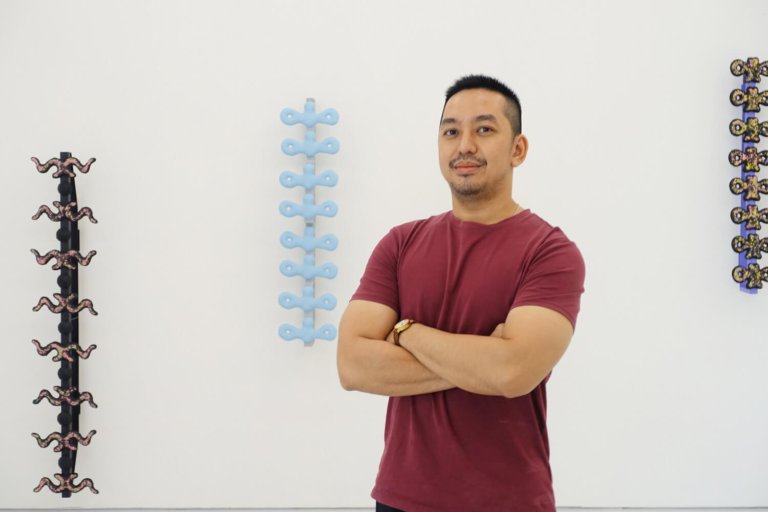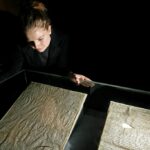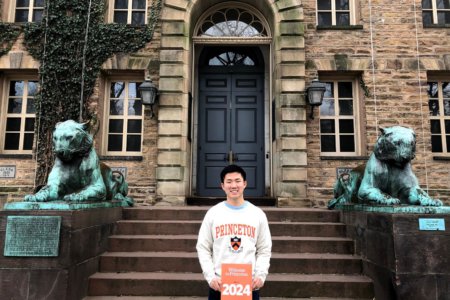
“Family Archive (Midday) II & III” now sits alongside Michelangelo, Georg Baselitz and Jenny Saville at the Ashmolean Museum, University of Oxford’s museum of art and archaeology. The work of art — oil and archival ink on photographic paper — by Master of Fine Art student Haffendi Anuar is the winner of this year’s Vivien Leigh Prize 2020. The subject? The humble “kain pelikat,” a traditional sarong worn by men since the Melaka Sultanate, and how it relates to questions of national, cultural and personal identity while living in Oxford.
It reflects Anuar’s motivations to move from the tropical shores of Malaysia to the UK, and from a professional art career to academia. “I also wanted to develop a new body of work that is urgent to me and in a way realign my values as an art practitioner,” Anuar says. We caught up with the multi-award-winning student to learn more about his Master of Fine Art, his most memorable classes thus far, and his future plans:
Why did you choose to pursue Master of Fine Art at Ruskin School of Art in the UK?
I chose the Master of Fine Art at the Ruskin School of Art, Oxford University because of the course which is known to be experimental and contextual. In addition, it values research in art practice.

Slow Tropical Snails, 2017 — a mixed media sculpture by Haffendi Anuar in Singapore/Kuala Lumpur and AI Gallery London. Source: Haffendi Anuar
I was also drawn to the other departments at the university, such as social sciences and anthropology, as well as the amazing museums they have. I did my undergraduate studies in London at Central Saint Martins, so I’m way familiar with the educational system here in the UK.
Do you think it would have made a difference if you studied your Master of Fine Art at a local institution? If so, why?
I guess it would have definitely been very different because the resources available at Oxford and the libraries helped a lot with research and shaping my thoughts around my work. The tutors in Oxford are well-known active practitioners, so it was great to get their insights into practice and contemporary art.
What has been your most memorable class so far and why?
The seminar sessions have been great. The format of my Master of Fine Art at the Ruskin School of Art is that we have to share and present with the cohort a piece of text, a video, or actually anything that we will then discuss in a group setting. The discussions are interesting and fun. There were a lot of tangent ideas that emerged during the discussions and required one to consider varying perspectives.

‘Machines for Modern’ living installation view at Battersea Power Station, by Haffendi Anuar, Battersea Power Station and Cass Sculpture Foundation. Source: Thierry Bal
How have your lecturers supported you in your studies thus far?
You are assigned a studio tutor that stays with you throughout the whole course. I had a great tutor. She was extremely attentive and critical with what I was doing, always pushing me to the best. I was encouraged a lot, but also told to slow down to thoughtfully consider what I was doing. You also get visiting tutors that are usually well-known artists in the field, that you could request to view your work and have them give feedback. It’s great that the programme focuses less on medium specificity and more on having diverse perspectives looking at your work to help direct it.
Do you get to apply the theories you gained in the lecture halls and classrooms to the real world?
The practical aspects of learning are from the various workshops that are available, from woodworking to printmaking to taking photos of artworks. The application of theories into our physical work was done in the studio.
The artworks created a “Project Space” (already installed) in which we would discuss them during the critic sessions. Unfortunately, due to COVID-19, we never had a final exhibition and thus were unable to invite others from outside the school to view the works.

‘head heap heat’ installation view, by Haffendi Anuar and the Institute of Contemporary Arts Singapore, LASALLE College of the Arts. Source: Weizhong Deng
What are your academic goals in doing your Master of Fine Art?
My main goal in pursuing the Master of Fine Art is to develop my practice further. In terms of research, I look into the relationship between Malaysia and the UK, from colonial to post-colonial eras. In addition, I wanted to be engaged in an art scene that is critical and open up new conversations with art practitioners here.
Do you plan to progress into further study after completing your Master of Fine Art?
I have thought about getting a PhD in Visual Art Practice, but will only submit applications next year. Meanwhile, I am currently based in Oxford for another year and have recently taken up a small art studio. I plan to do some work for an exhibition at Oxford University in May next year.
Here’s Anuar’s winning entry:
View this post on Instagram










